Grand tour of Quebec and Gaspésie
MONTRÉAL - SAINT-ALEXIS-DES-MONTS - SAINT-FÉLICIEN - SAGUENAY - TDOUSSAC - SAINTE-ANNE-DES-MONTS - PERCÉ- CARLETON - RIMOUSKI - QUÉBEC
Itinerary
-
Day 1 Montreal
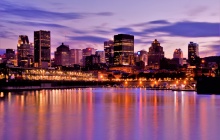 Arriving in Montreal, lose yourself in the streets of the Plateau and end your first evening by admiring the sunset at the foot of Saint Joseph's Oratory.
Arriving in Montreal, lose yourself in the streets of the Plateau and end your first evening by admiring the sunset at the foot of Saint Joseph's Oratory.
-Accommodation: Hotel
-
Day 2 Montréal
 For this first day, climb the Mont Royal to admire the amazing view of the city centre. Go down through the Mile-End district and enjoy a brunch (maple syrup pancakes are wonderfully delicious there).
For this first day, climb the Mont Royal to admire the amazing view of the city centre. Go down through the Mile-End district and enjoy a brunch (maple syrup pancakes are wonderfully delicious there).
- Accommodation: Hotel
-
Day 3 Montréal / Saint-Alexis-des-Monts
 Welcome to Mauricie! Saint-Alexis-des-Monts has more than 600 lakes, including the famous Lac Sacacomie and Lac Saint-Alexis, nestled in the heart of its village.
Welcome to Mauricie! Saint-Alexis-des-Monts has more than 600 lakes, including the famous Lac Sacacomie and Lac Saint-Alexis, nestled in the heart of its village.
- Transport: 140 km - about 2h
- Accommodation: Lodge -
Day 4 Saint-Alexis-des-Monts
 Embark on a canoe to join the giant trout in the centre of the lake, which reminds us that the city is officially the capital of speckled trout.
Embark on a canoe to join the giant trout in the centre of the lake, which reminds us that the city is officially the capital of speckled trout.
- Accommodation: Lodge
-
Day 5 Saint-Alexis-des-Monts
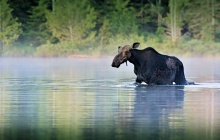 On foot or by bike, cross the brook bridge along the Rivière du Loup to admire the beauty of the place.
On foot or by bike, cross the brook bridge along the Rivière du Loup to admire the beauty of the place.
-Accommodation: Lodge
-
Day 6 Saint-Alexis-des-Monts / St-Jean Lake
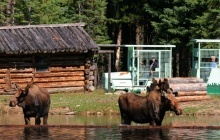 You'll follow the Saint-Maurice Valley, trapped in the heart of the Laurentian Mountains, to St-Jean lake, where pioneer history, First Nations culture and sumptuous landscapes blend harmoniously. An exciting adventure also awaits you at the Wildlife Zoo of Saint-Félicien, where you'll discover the different ecosystems of the Boréalie.
You'll follow the Saint-Maurice Valley, trapped in the heart of the Laurentian Mountains, to St-Jean lake, where pioneer history, First Nations culture and sumptuous landscapes blend harmoniously. An exciting adventure also awaits you at the Wildlife Zoo of Saint-Félicien, where you'll discover the different ecosystems of the Boréalie.
Suggested activity(ies) ($):
- St Félicien Wildlife Zoo- Transport: 345 km - about 4h
-Accommodation: Hotel -
Day 7 St-Jean Lake
 Experience the immensity of St-Jean lake. Are you a water sports enthusiast or a hiker? Whatever your mood, you're sure to find what you're looking for in the wide range of activities offered here.
Experience the immensity of St-Jean lake. Are you a water sports enthusiast or a hiker? Whatever your mood, you're sure to find what you're looking for in the wide range of activities offered here.
- Accommodation: Hotel
-
Day 8 St-Jean Lake / Saguenay
 Take the road to Saguenay Fjord National Park. The only navigable fjord in North America, which is home to more than 16 marine species typical of the Arctic. A breathtaking landscape.
Take the road to Saguenay Fjord National Park. The only navigable fjord in North America, which is home to more than 16 marine species typical of the Arctic. A breathtaking landscape.
-Accommodation: Lodge
-
Day 9 Saguenay
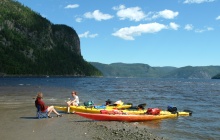 Many activities are available to admire the vastness of this Fjord. Discover it on foot, by bike or by kayak!
Many activities are available to admire the vastness of this Fjord. Discover it on foot, by bike or by kayak!
- Accommodation: Lodge
-
Day 10 Saguenay / Tadoussac
 Tadoussac is a maritime crossroads composed of the Saint-Laurent River and the Saguenay Fjord. It is the ideal place to go and meet the whales. A word of advice: go for a kayak that will allow you to get closer to it without disturbing them.
Tadoussac is a maritime crossroads composed of the Saint-Laurent River and the Saguenay Fjord. It is the ideal place to go and meet the whales. A word of advice: go for a kayak that will allow you to get closer to it without disturbing them.
Suggested activity(ies) ($):
- Whales watching cruise- Transport: 126 km - about 1h30
- Accommodation: Hotel -
Day 11 Gaspésie National Park
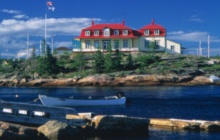 Head to the Gaspésie National Park! It protects a unique fauna and flora. Look for the caribou herd that lives in the park.
Head to the Gaspésie National Park! It protects a unique fauna and flora. Look for the caribou herd that lives in the park.
- Transport: 310 km - about 5h
-Accommodation: Hotel/Lodge -
Day 12 Gaspésie National Park
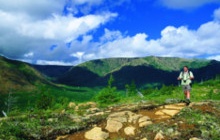 Spend the morning in peace by pedal boat on the lake, then in the afternoon, climb the mountains using the hiking trails.
Spend the morning in peace by pedal boat on the lake, then in the afternoon, climb the mountains using the hiking trails.
-Accommodation: Hotel/Lodge
-
Day 13 Gaspésie National Park
 Why not an alpine hike in the heart of the Chic-Chocs Mountains? In summer and winter they are annually covered with snow.
Why not an alpine hike in the heart of the Chic-Chocs Mountains? In summer and winter they are annually covered with snow.
-Accommodation: Hotel/Lodge
-
Day 14 Gaspesie National Park / Percé
 Go admire the famous Percé Rock and its neighbour, Bonaventure Island, where thousands of gannets nest every year.
Go admire the famous Percé Rock and its neighbour, Bonaventure Island, where thousands of gannets nest every year.
- Transport: 270 km - about 3h30
- Accommodation: Hotel -
Day 15 Percé
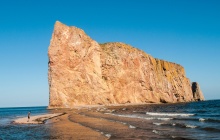 Walk on the glass platform suspended at an altitude of 200 m from the UNESCO World Geopark and enjoy a good meal on a terrace by the sea with a local beer (awarded worldwide!).
Walk on the glass platform suspended at an altitude of 200 m from the UNESCO World Geopark and enjoy a good meal on a terrace by the sea with a local beer (awarded worldwide!).
Suggested activity(ies) ($):
- Bonaventure Island and Percé Rock Cruise- Accommodation: Hotel
-
Day 16 Percé / Carleton
 Ideal for water sports, Baie des Chaleurs is a member of the most beautiful bays in the world Club.
Ideal for water sports, Baie des Chaleurs is a member of the most beautiful bays in the world Club.
- Transport: 200 km - about 3h
- Accommodation: Hotel -
Day 17 Carleton / Rimouski
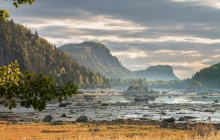 Next stop: the Bas-St-Laurent coast where the splendor of the river awaits you. Take the opportunity to discover the Bic National Park. Hiking area where you can enjoy a panoramic view of the river.
Next stop: the Bas-St-Laurent coast where the splendor of the river awaits you. Take the opportunity to discover the Bic National Park. Hiking area where you can enjoy a panoramic view of the river.
- Transport: 245 km - about 3h
- Accommodation: Hotel -
Day 18 Rimouski
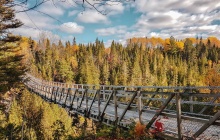 Are you a nature lover? Rimouski Wildlife Reserve will seduce you. It offers you a one-on-one experience with nature. Take the opportunity to go for a walk in the forest, rent a kayak, or go meet the famous black bear!
Are you a nature lover? Rimouski Wildlife Reserve will seduce you. It offers you a one-on-one experience with nature. Take the opportunity to go for a walk in the forest, rent a kayak, or go meet the famous black bear!
- Accommodation: Hotel
-
Day 19 Rimouski / Quebec city
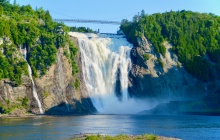 A few steps from Quebec City are the Montmorency Falls. Take the panoramic circuit to admire the 83 m high waterfall and even cross the suspension bridge above to feel its full force.
A few steps from Quebec City are the Montmorency Falls. Take the panoramic circuit to admire the 83 m high waterfall and even cross the suspension bridge above to feel its full force.
- Transport: 317 km - about 3h30
- Accommodation: Hotel -
Day 20 Quebec city
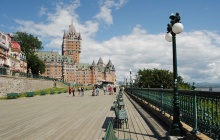 Let yourself be seduced by the narrow cobbled streets of Quebec City. The picturesque old town is also listed as a UNESCO World Heritage Site. You will not be able to miss the Château Frontenac which dominates above the city.
Let yourself be seduced by the narrow cobbled streets of Quebec City. The picturesque old town is also listed as a UNESCO World Heritage Site. You will not be able to miss the Château Frontenac which dominates above the city.
- Accommodation: Hotel
-
Day 21 Québec / Montréal Airport
 It's time to drop your car off at the airport and take a flight back.
It's time to drop your car off at the airport and take a flight back.
- Transport: 276 km - about 3h
Period & budget
When to travel?
The best period for travelling is during the following months:
| Jan | Feb | Mar | Apr | May | Jun | Jul | Aug | Sep | Oct | Nov | Dec |
Price
The budget is an indication of the price per person, subject to availability. Your local agent will send you a customized quote with the exact price. The price can vary according to availability, level of services, period of travel, number of participants, booking time frame and other items.
Included
- 20 nights accommodation
- 19 days car hire with CDW insurance and unlimited mileage
- Ferry between Baie Comeau-Matane
- Applicable taxes
- Assistance 24 hours phone number
Not included
- The personalized roadbook
- Flights (Available upon request)
- Gasoline
- Lunches and dinners
- Personal expenses
Terms and conditions
Booking conditions
Invoice procedure
Cancellation policy
If cancellation occurs:
- More than 31 days before departure: 20% of the total booking amount (excluding insurance and fixed fees)
- Between 30 and 21 days before departure: 35% of the total booking amount (excluding insurance and fixed fees)
- Between 20 and 14 days before departure: 50% of the total booking amount (excluding insurance and fixed fees)
- Between 13 and 7 days before departure: 75% of the total booking amount (excluding insurance and fixed fees)
- Less than 7 days before departure: 100% of the total booking amount (excluding insurance and fixed fees)
Regardless of the cancellation or contract modification date, the following fees are added to the standard cancellation terms above:
- Airfare fees: If your flight ticket has to be issued well in advance—often to secure the best fare—100% of the non-refundable flight costs will be charged in case of cancellation or change. In this case, the standard cancellation terms apply only to the land portion of the trip.
- Land service fees: Any non-refundable fees incurred early for firm bookings will be charged in case of cancellation.
- Insurance: Whether you purchased multi-risk or cancellation insurance, the insurance premium is non-refundable under any circumstances.
The date the written notice is received will be considered the official cancellation date and will determine the applicable cancellation fees.
Altaï Canada may also cancel a trip due to exceptional circumstances considered force majeure (e.g., volcanic eruptions, social unrest, strikes, severe weather) that could compromise the safety of participants. In such cases, all amounts paid will be fully refunded, but no additional compensation can be claimed.
Changes to travel contract
Pricing
Contract transfer
Insurance
Practical info
Staff
- A day by day (itinerary) description
- Destination description
- Useful tips on driving
- Cities and parks maps
- Activities description
Food
Accommodation
Transportation
Budget & exchange
Tips
Supplied equipment
Luggage
Passport
Health information & recommendations
Weather
Electricity
Local time
Topography
Sustainable tourism
- A fair economical repartition
- The improvement of local teams’ working conditions and their awareness of the protection of the environment
- The information of travelers about respecting the local population and environment and the collection of their feelings at their return.
- Avoid letting waste out, throw it in the trash can or bring it with you
- Use potable water sparingly (take a shower instead of a bath and report any leaks) and avoid wasting it (use biodegradable soap to wash yourself)
- Avoid damaging cultural sites: don’t touch the statues, don’t move the stones and objects
- Exchange instead of giving (too Important gifts can destabilize the local economic stability of the country depending on their living standards)
- When taking a walk, especially in some fragile ecosystems, observe the fauna from afar, do not go beyond beaten roads, limit stamping and do not bring any souvenirs: give up picking rare flowers picking fossils...
- In some hotels, you can have individual air conditioning. It is advised to systematically switching it off when you’re out of the room to avoid energetical overconsumption and greenhouse gas emission.


